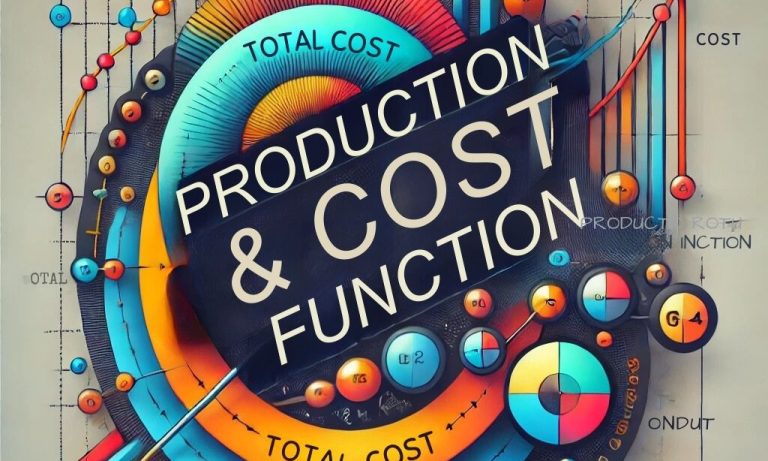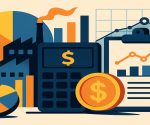The production and cost function are fundamental concepts in economics that help businesses. Understand how inputs become outputs and how costs arise in the process. A production function describes the relationship between the amount of inputs and the corresponding output. This is matched by the cost function, which describes how changing levels of production affect total costs. Together, these functions enable businesses to optimize their levels of production, minimize their costs, and maximize profitability.
What is Production Function?
A production function defines how inputs, such as labor, capital, and raw materials, are combined to produce output. Essentially, it represents the technical relationship between factors of production and the final goods or services produced. This helps businesses determine the most efficient combination of resources to maximize production.
Where:
- Q = Quantity of bread produced
- L = Labor (number of workers)
- K = Capital (number of ovens)
Example of a Production Function
Let’s consider a bakery. The bakery uses two main inputs:
- Labor (L): Number of workers.
- Capital (K): Machines and ovens used for baking.
If the bakery employs 5 workers and uses 3 ovens, it might produce 100 loaves of bread. If it employs 10 workers and uses 4 ovens, it could produce 250 loaves. The production function helps the bakery understand the relationship between labor, capital, and output.
Types of Production Functions
Understanding the different types of production functions helps businesses determine the best approach to managing inputs for optimal output. Below are some of the most commonly used types:
Linear Production Function
In a linear production function, output increases proportionally with an increase in inputs. This means that doubling the labor or capital will result in doubling the output.
Example: Imagine a factory that produces t-shirts. If the factory has 5 workers producing 100 shirts per day, increasing the workforce to 10 workers could lead to 200 shirts per day.
Cobb-Douglas Production Function
The Cobb-Douglas production function assumes that inputs such as labor and capital are used in fixed proportions but with diminishing returns. This means that as more labor or capital is added, the additional output produced decreases after a certain point.
Example: For a tech company, if adding one programmer to a team of 5 increases productivity by 10%, adding a 6th programmer might only increase productivity by 7%. The law of diminishing returns is at play here.
The Cobb-Douglas function can be written as:
Where:
- A = Total factor productivity
- L = Labor
- K = Capital
- α(alpha) and β(beta) = Output elasticities of labor and capital
Leontief Production Function
The Leontief production function assumes fixed proportions of inputs. If one unit of labor and one unit of capital is required to produce one unit of output, increasing one input without increasing the other won’t increase output.
Example: A factory producing cars needs exactly one worker per machine. If one worker leaves or if one machine breaks, output drops by one unit, regardless of other available resources.
CES (Constant Elasticity of Substitution) Production Function
The CES production function allows for varying proportions of labor and capital. It assumes that the inputs can be substituted for each other based on a constant elasticity of substitution.
Example: In a modern manufacturing plant, robots (capital) might replace some of the manual labor (labor) without affecting the output. The ability to substitute labor with capital is a characteristic of the CES function.
What is Cost Function?
The cost function describes the relationship between the quantity of output produced and the total costs incurred by a company. It helps businesses determine how different levels of output affect their costs, which is crucial for setting prices, managing production, and maximizing profits.
Example of a Cost Function
Let’s use the example of the bakery again. The bakery’s fixed costs (such as rent, salaries of permanent staff, and equipment maintenance) remain constant, regardless of how many loaves of bread are produced. However, variable costs, such as flour, sugar, and electricity, increase as the bakery produces more loaves.
The cost function is typically expressed as:
Where:
- TC = Total cost
- FC = Fixed cost
- VC(Q) = Variable cost, depending on the quantity of output (Q)
If the bakery produces 100 loaves, its total cost might be ₹500. If it produces 200 loaves, the total cost might rise to ₹900, reflecting the increase in variable costs.
Components of Cost Functions
- Fixed Costs (FC): These do not change with production levels. Examples include rent, insurance, and salaried workers.
- Variable Costs (VC): These change as production levels increase or decrease. Examples include raw materials, hourly wages, and utility costs.
- Total Cost (TC): The sum of fixed and variable costs.
Understanding Cost Curves
Cost curves are graphical representations of the relationship between cost and output. By plotting cost data, businesses can visualize how different types of costs behave as production levels change.
Total Cost Curve
The total cost curve represents the total cost of producing a certain quantity of output. It is the sum of fixed and variable costs at each level of production.
- Shape: In the short run, the total cost curve is typically upward-sloping, reflecting the increasing costs as more units are produced.
- Significance: Businesses can use the total cost curve to predict how costs will increase with increased production and to identify optimal production levels.
Marginal Cost Curve
The marginal cost curve shows the additional cost of producing one more unit of output. It is derived by calculating the change in total cost as production increases.
- Shape: The marginal cost curve typically has a U-shape, reflecting diminishing returns. Initially, marginal costs decrease as production becomes more efficient, but eventually, they increase due to diminishing returns.
- Significance: Understanding marginal cost is crucial for pricing decisions. A business should set prices at least equal to marginal cost to avoid losses and ensure profitability.
Average Cost Curve
The average cost curve represents the cost per unit of output. It is calculated by dividing the total cost by the number of units produced.
- Shape: Like the marginal cost curve, the average cost curve typically has a U-shape. Initially, average costs decrease as production increases, but after a certain point, they start to rise due to diminishing returns.
Factors Affecting Production and Cost
There are various factors that influence both production levels and associated costs. Understanding these factors helps businesses make informed decisions to enhance efficiency and profitability.
- Technological Advancements: Technology enhances production by improving resource efficiency and increasing productivity. It helps reduce labor costs, material waste, and overall production expenses.
- Labor Costs and Productivity: Labor costs, including wages, benefits, and training, make up a significant portion of production expenses. Efficient labor management and improved productivity can lead to lower costs and higher output.
- Raw Material Costs: Fluctuating raw material prices can impact production costs. A steady supply of affordable materials helps keep costs low and maintain profitability, which influences product pricing.
Conclusion
The production and cost functions are vital for understanding how businesses manage resources and control costs. By examining the relationship between inputs and output (the production function) and analyzing how output levels affect costs (the cost function), businesses can make informed decisions that maximize efficiency and profitability. Utilizing cost curves and understanding the factors that affect production and cost will further enhance decision-making. It is competitiveness in the marketplace.
Production and Cost Function FAQs
What is a production function?
The production function represents how different inputs such as labor, capital, and raw materials combine to produce output. It is useful in understanding the efficiency of production.
What are the various types of production functions?
There are four types: Linear, Cobb-Douglas, Leontief, and CES. Each represents a different way in which inputs interact to create output.
What is a cost function?
The cost function shows how the total costs change with the changing level of production. The companies can use it for their production cost management to estimate profitability.
What are cost curves?
These are graphical representations that portray how costs change with the different production levels. The Cost curves include the Total Cost Curve, Marginal Cost Curve, and Average Cost Curve
What determines production and cost?
Technological improvements in inputs, input prices, economies of scale, and managerial efficiency are important.


